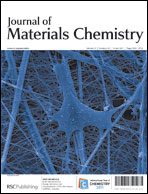Conductivity regulation of the mixed-valence tetrathiafulvalene nanowire/poly(methyl methacrylate) composites using heterogeneous tetrathiafulvalene derivatives†
Abstract
We describe the influence on the conductivity of the mixed-valence tetrathiafulvalene (TTF)/poly(methyl methacrylate) (PMMA) composites by incorporating heterogeneous TTF derivatives. We prepared the uniformly dispersed PMMA composites from the mixtures containing TTF


 Please wait while we load your content...
Please wait while we load your content...